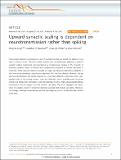| dc.contributor.author | Fong, Ming-fai | |
| dc.contributor.author | Newman, Jonathan P. | |
| dc.contributor.author | Potter, Steve M. | |
| dc.contributor.author | Wenner, Peter | |
| dc.date.accessioned | 2015-04-30T14:15:00Z | |
| dc.date.available | 2015-04-30T14:15:00Z | |
| dc.date.issued | 2015-03 | |
| dc.date.submitted | 2014-02 | |
| dc.identifier.issn | 2041-1723 | |
| dc.identifier.uri | http://hdl.handle.net/1721.1/96856 | |
| dc.description.abstract | Homeostatic plasticity encompasses a set of mechanisms that are thought to stabilize firing rates in neural circuits. The most widely studied form of homeostatic plasticity is upward synaptic scaling (upscaling), characterized by a multiplicative increase in the strength of excitatory synaptic inputs to a neuron as a compensatory response to chronic reductions in firing rate. While reduced spiking is thought to trigger upscaling, an alternative possibility is that reduced glutamatergic transmission generates this plasticity directly. However, spiking and neurotransmission are tightly coupled, so it has been difficult to determine their independent roles in the scaling process. Here we combined chronic multielectrode recording, closed-loop optogenetic stimulation, and pharmacology to show that reduced glutamatergic transmission directly triggers cell-wide synaptic upscaling. This work highlights the importance of synaptic activity in initiating signalling cascades that mediate upscaling. Moreover, our findings challenge the prevailing view that upscaling functions to homeostatically stabilize firing rates. | en_US |
| dc.description.sponsorship | National Science Foundation (U.S.). Graduate Research Fellowship (09-603) | en_US |
| dc.description.sponsorship | National Science Foundation (U.S.). Graduate Research Fellowship (08-593) | en_US |
| dc.description.sponsorship | National Science Foundation (U.S.). Integrative Graduate Education and Research Traineeship (Fellowship DGE-0333411) | en_US |
| dc.description.sponsorship | Emory University (NI SPINR Fellowship) | en_US |
| dc.language.iso | en_US | |
| dc.publisher | Nature Publishing Group | en_US |
| dc.relation.isversionof | http://dx.doi.org/10.1038/ncomms7339 | en_US |
| dc.rights | Creative Commons Attribution | en_US |
| dc.rights.uri | http://creativecommons.org/licenses/by/4.0/ | en_US |
| dc.source | Nature Publishing Group | en_US |
| dc.title | Upward synaptic scaling is dependent on neurotransmission rather than spiking | en_US |
| dc.type | Article | en_US |
| dc.identifier.citation | Fong, Ming-fai, Jonathan P. Newman, Steve M. Potter, and Peter Wenner. “Upward Synaptic Scaling Is Dependent on Neurotransmission Rather Than Spiking.” Nature Communications 6 (March 9, 2015): 6339. | en_US |
| dc.contributor.department | Picower Institute for Learning and Memory | en_US |
| dc.contributor.mitauthor | Fong, Ming-fai | en_US |
| dc.contributor.mitauthor | Newman, Jonathan P. | en_US |
| dc.relation.journal | Nature Communications | en_US |
| dc.eprint.version | Final published version | en_US |
| dc.type.uri | http://purl.org/eprint/type/JournalArticle | en_US |
| eprint.status | http://purl.org/eprint/status/PeerReviewed | en_US |
| dspace.orderedauthors | Fong, Ming-fai; Newman, Jonathan P.; Potter, Steve M.; Wenner, Peter | en_US |
| dc.identifier.orcid | https://orcid.org/0000-0002-2336-4531 | |
| dc.identifier.orcid | https://orcid.org/0000-0002-5425-3340 | |
| mit.license | PUBLISHER_CC | en_US |
| mit.metadata.status | Complete | |
